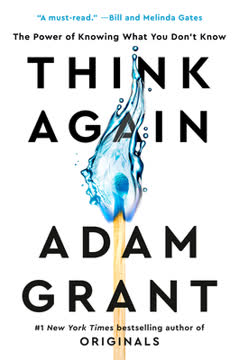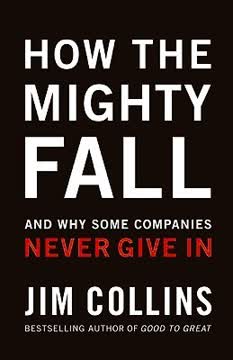Key Takeaways
1. Level 5 Leadership: Humility and Professional Will
Level 5 leaders channel their ego needs away from themselves and into the larger goal of building a great company.
Paradoxical blend. Level 5 leaders combine personal humility with intense professional will. They are ambitious for their company, not themselves, and attribute success to factors outside themselves while taking responsibility for poor results.
Key characteristics. These leaders:
- Display a compelling modesty, shunning public adulation
- Act with quiet, calm determination; rely principally on inspired standards, not charisma
- Channel ambition into the company, not the self
- Look in the mirror, not out the window, to apportion responsibility for poor results
Contrast with comparison companies. Unlike the often charismatic, celebrity leaders of comparison companies, Level 5 leaders are more like Lincoln than Patton – more dedicated to organizational success than personal glory.
2. First Who, Then What: Get the Right People on the Bus
The executives who ignited the transformations from good to great did not first figure out where to drive the bus and then get people to take it there. No, they first got the right people on the bus (and the wrong people off the bus) and then figured out where to drive it.
People over strategy. Good-to-great companies focused on getting the right people in key positions before determining their strategy or vision. This approach provides flexibility in a changing world and reduces the need for motivation and management.
Key principles:
- When in doubt, don't hire – keep looking
- When you know you need to make a people change, act
- Put your best people on your biggest opportunities, not your biggest problems
Rigorous, not ruthless. While strict in their people decisions, good-to-great companies were not cruel. They created a culture where the right people thrived and the wrong people chose to leave of their own accord.
3. Confront the Brutal Facts: The Stockdale Paradox
You must retain faith that you will prevail in the end, regardless of the difficulties AND at the same time confront the most brutal facts of your current reality, whatever they might be.
Unwavering faith amid harsh realities. Good-to-great companies maintained absolute faith that they would prevail while simultaneously confronting the brutal facts of their current situation. This paradox, named after Admiral James Stockdale, allowed them to make tough decisions without losing hope.
Creating a climate of truth:
- Lead with questions, not answers
- Engage in dialogue and debate, not coercion
- Conduct autopsies without blame
- Build "red flag" mechanisms that turn information into information that cannot be ignored
Contrast with comparison companies. While good-to-great companies confronted reality, comparison companies often fell into denial, nostalgia for the past, or blame.
4. The Hedgehog Concept: Simplicity in Three Circles
To go from good to great requires transcending the curse of competence. It requires the discipline to say, "Just because we are good at it—just because we're making money and generating growth—doesn't necessarily mean we can become the best at it."
Simplicity within three circles. The Hedgehog Concept is the intersection of three circles:
- What you can be the best in the world at
- What drives your economic engine
- What you are deeply passionate about
Rigorous thinking process. Developing a Hedgehog Concept is not a one-time event but an iterative process involving intense dialogue and debate. It often takes years to crystallize.
Examples:
- Walgreens: Be the best, most convenient drugstores with high profit per customer visit
- Wells Fargo: Be the best at running a bank like a business, focused on the western United States
- Kimberly-Clark: Be the best at paper-based consumer products
5. Culture of Discipline: Freedom within a Framework
Sustained great results depend upon building a culture full of self-disciplined people who take disciplined action, fanatically consistent with the three circles.
Disciplined people, thought, and action. Good-to-great companies build a consistent system with clear constraints, but give people freedom and responsibility within that framework. They hire self-disciplined people who don't need to be managed, then manage the system, not the people.
Key aspects:
- Rinsing cottage cheese: Fanatical attention to detail
- Freedom and responsibility within a framework
- Adherence to the Hedgehog Concept
- A "stop doing" list is as important as a "to do" list
Contrast with comparison companies. While good-to-great companies had freedom with responsibility, comparison companies alternated between freedom and tight control, never finding the right balance.
6. Technology Accelerators: Thoughtful Application
Technology-induced change is nothing new. The real question is not, What is the role of technology? Rather, the real question is, How do good-to-great organizations think differently about technology?
Accelerator, not creator. Good-to-great companies use technology as an accelerator of momentum, not a creator of it. They avoid technology fads and bandwagons, yet become pioneers in the application of carefully selected technologies.
Key principles:
- Technology must fit with the Hedgehog Concept
- If used right, technology becomes an accelerator of momentum, not a creator of it
- Good-to-great companies think differently about technology
Examples:
- Nucor: Pioneered the application of mini-mill technology
- Walgreens: Early adopter of satellite communication for pharmacy operations
7. The Flywheel Effect: Consistent Push Creates Momentum
Good to great comes about by a cumulative process—step by step, action by action, decision by decision, turn by turn of the flywheel—that adds up to sustained and spectacular results.
Momentum through consistent effort. The transformation from good to great is not a single defining action, grand program, or miracle moment. It's a process of pushing a giant, heavy flywheel that builds momentum over time.
Key aspects:
- No single defining moment or "breakthrough"
- Flywheel effect creates alignment and deep engagement
- Media often only notices once the flywheel is turning fast
Contrast with the doom loop. Comparison companies often fall into a doom loop of reactive change, lurching back and forth without consistency, never gaining momentum.
8. Clock Building, Not Time Telling: Enduring Greatness
Having a great idea or being a charismatic visionary leader is "time telling"; building a company that can prosper far beyond the presence of any single leader and through multiple product life cycles is "clock building."
Building enduring companies. Good-to-great companies focus on building the organizational capabilities that will endure beyond any single product, market cycle, or charismatic leader.
Key aspects:
- Focus on building the organization, not just delivering results
- Develop a cadre of leaders who can continue the legacy
- Create systems and cultures that perpetuate success
Examples:
- Hewlett-Packard: Built on a foundation of technical contribution and respect for the individual
- 3M: Fostered a culture of innovation that transcended any single product
9. Preserve the Core / Stimulate Progress: Balancing Continuity and Change
Enduring great companies preserve their core values and purpose while their business strategies and operating practices endlessly adapt to a changing world.
Dynamic conservatism. Good-to-great companies maintain unwavering commitment to core values and purpose while continuously adapting strategies and practices to a changing world.
Key elements:
- Core ideology: Fundamental reason for being beyond just making money
- BHAGs (Big Hairy Audacious Goals): Ambitious long-term objectives
- Experimentation and evolution within the framework of core ideology
Examples:
- Johnson & Johnson: Credo guides decisions through changing times
- Walt Disney: Consistent focus on wholesome family entertainment while innovating in delivery methods
10. Good to Great to Built to Last: A Comprehensive Framework
To go from good to great requires transcending the curse of competence.
Integrated approach. The Good to Great concepts lay the groundwork for building an enduring great company, while Built to Last concepts elevate the company to iconic status.
Key stages:
- Disciplined People (Level 5 Leadership, First Who...Then What)
- Disciplined Thought (Confront the Brutal Facts, Hedgehog Concept)
- Disciplined Action (Culture of Discipline, Technology Accelerators)
- Building to Last (Clock Building, Preserve the Core / Stimulate Progress)
Application beyond business. These concepts can apply to any organization or individual seeking to move from good to great, whether in business, non-profit, or personal life.
Last updated:
FAQ
What's "Good to Great" about?
- Transformation from good to great: "Good to Great" by Jim Collins examines why some companies successfully transition from being good to great, while others do not.
- Research-based insights: The book is based on a five-year research project comparing companies that made the leap to greatness with those that did not.
- Key principles: It introduces key concepts such as Level 5 Leadership, the Hedgehog Concept, and the Flywheel, which are essential for understanding how companies achieve sustained greatness.
Why should I read "Good to Great"?
- Proven strategies for success: The book offers strategies and insights that can help organizations and individuals achieve exceptional results.
- Timeless principles: It presents principles that remain relevant regardless of changes in the business environment, making it a valuable resource for leaders and managers.
- Inspiration and guidance: "Good to Great" provides practical guidance for those seeking to transform their organizations and achieve long-term success.
What are the key takeaways of "Good to Great"?
- Level 5 Leadership: Great companies have leaders who combine personal humility with professional will, focusing on the success of the organization.
- First Who, Then What: Successful transformations begin by getting the right people on the bus and the wrong people off, before deciding on the direction.
- Hedgehog Concept: Companies must identify what they can be the best in the world at, what drives their economic engine, and what they are deeply passionate about.
What is Level 5 Leadership according to Jim Collins?
- Blend of humility and will: Level 5 Leadership is characterized by a paradoxical blend of personal humility and professional will.
- Ambition for the company: These leaders are ambitious for the company, not themselves, and set up successors for success.
- Workmanlike diligence: They focus on results and take responsibility for failures while attributing success to others.
What is the Hedgehog Concept in "Good to Great"?
- Three intersecting circles: The Hedgehog Concept arises from understanding what you can be the best at, what drives your economic engine, and what you are deeply passionate about.
- Not a goal or strategy: It is an understanding of what the organization can truly excel at, guiding all decisions and actions.
- Focus and simplicity: This concept ensures that the company remains focused on its core strengths and opportunities.
How does "Good to Great" define the Flywheel and the Doom Loop?
- Flywheel effect: The Flywheel represents the cumulative effect of many small initiatives that lead to a breakthrough and sustained momentum.
- Doom Loop: In contrast, the Doom Loop is characterized by reactionary decisions and lack of consistent direction, leading to mediocrity or decline.
- Consistent effort: Great companies achieve success through consistent effort and disciplined action, gradually building momentum over time.
What role does technology play in "Good to Great"?
- Accelerator, not creator: Technology is seen as an accelerator of momentum, not a creator of it.
- Disciplined application: Great companies apply technology in a disciplined manner, ensuring it aligns with their core strengths.
- Avoiding the technology trap: The book warns against chasing new technologies without understanding their relevance to the core business.
What is the significance of "First Who, Then What" in "Good to Great"?
- Right people first: The principle emphasizes getting the right people on the bus and the wrong people off before deciding on the company's direction.
- Adaptability and flexibility: By focusing on who first, companies can more easily adapt to changes and challenges.
- Self-motivated individuals: The right people are self-motivated and do not need to be tightly managed, allowing the organization to focus on strategic decisions.
How does "Good to Great" address the fear of change?
- Confronting brutal facts: Companies must confront the brutal facts of their reality without losing faith in their ability to prevail.
- Stockdale Paradox: This involves maintaining unwavering faith while acknowledging the current challenges.
- Balanced perspective on technology: Great companies maintain a balanced perspective on technology, avoiding reactionary changes driven by fear.
What are the best quotes from "Good to Great" and what do they mean?
- "Good is the enemy of great." This quote highlights that settling for good often prevents achieving greatness.
- "You must maintain unwavering faith..." Known as the Stockdale Paradox, it emphasizes balancing optimism with a realistic assessment of challenges.
- "The right people don’t need to be tightly managed..." This underscores the value of having the right people in an organization.
How can the concepts in "Good to Great" be applied to personal development?
- Identify your Hedgehog Concept: Individuals can identify their unique strengths, passions, and economic drivers to guide their growth.
- Focus on disciplined action: Apply principles of disciplined thought and action to personal goals, ensuring efforts are consistent and aligned with long-term objectives.
- Surround yourself with the right people: Like great companies, individuals benefit from surrounding themselves with supportive, motivated, and like-minded people.
Review Summary
Good to Great is widely regarded as a seminal business book, offering insights on how companies transition from mediocrity to excellence. Readers appreciate Collins' research-based approach and practical principles, such as Level 5 Leadership and the Hedgehog Concept. However, some criticize the book's hindsight bias and question the longevity of its case studies. While many find the concepts valuable for both business and personal growth, others argue the advice is common sense repackaged. Despite its age, the book remains influential in management literature.
Similar Books
Download PDF
Download EPUB
.epub digital book format is ideal for reading ebooks on phones, tablets, and e-readers.



















